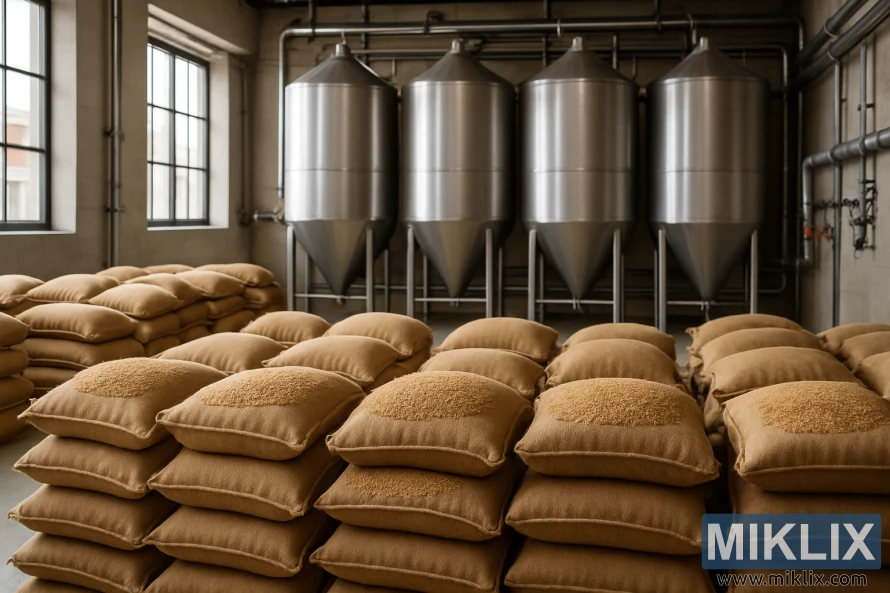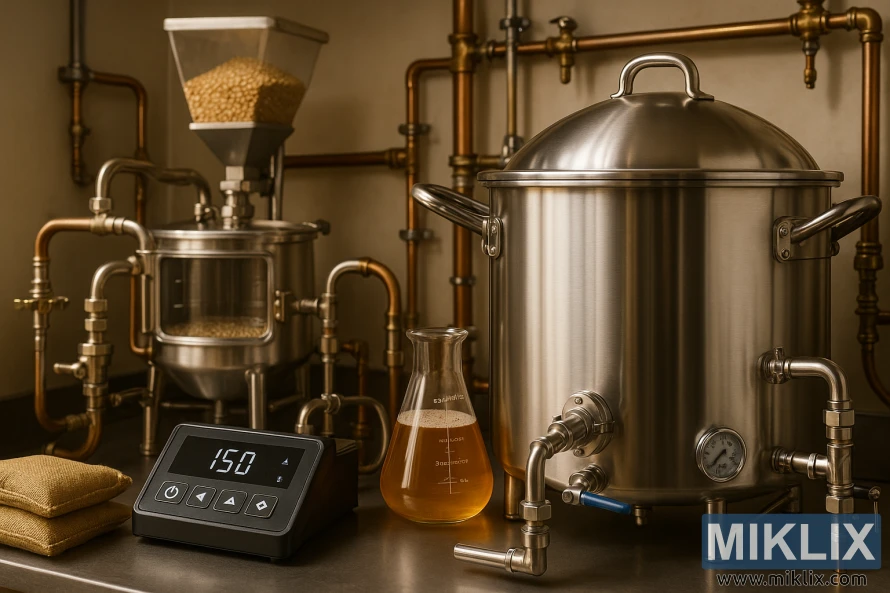Using Wheat as an Adjunct in Beer Brewing
Published: July 20, 2025 at 11:19:00 AM UTC
Beer brewing has a rich history, with various styles emerging over time. Wheat has been a key ingredient for centuries. It's a staple in certain beer styles, like hefeweizen and witbier. Using wheat as an adjunct in beer brewing adds complexity and depth. It allows brewers to create unique flavor profiles and textures. These enhancements make the drinking experience more enjoyable.

Key Takeaways
- Wheat has been used in beer brewing for centuries, with various styles emerging over time.
- The use of wheat as an adjunct adds complexity and depth to the final product.
- Brewers can create unique flavor profiles and textures by incorporating wheat into their brews.
- Wheat is a staple ingredient in certain beer styles, such as hefeweizen and witbier.
- The incorporation of wheat can enhance the overall drinking experience.
Understanding Wheat's Role in Beer Production
Wheat is essential in brewing, adding flavor and texture to various beers. Its use in beer-making has a long history, mainly in European styles like hefeweizen and witbier.
Adding wheat to beer recipes can greatly change the final product. It brings a unique character to beers, making them more refreshing and complex in flavor.
- A lighter, more refreshing taste
- Increased complexity in flavor profile
- Improved texture and mouthfeel
Wheat's impact on beer production is significant, affecting both taste and the brewing process. Knowing the history and use of wheat in brewing is key to making top-notch wheat beers.
By using wheat's special properties, brewers can craft a variety of beer styles. These cater to different tastes and preferences.
The History of Wheat Beer Styles
Wheat beer's history spans centuries, with various cultures crafting their own unique styles. The German hefeweizen and Belgian witbier stand out among these traditional brews. Each style boasts its own set of characteristics and brewing methods.
The German hefeweizen is famous for its cloudy look and flavors reminiscent of bananas or cloves. It hails from Bavaria and combines wheat and barley malts. In contrast, Belgian witbier is light in color and citrusy, often spiced with coriander and orange peel.
Other notable styles include the Dutch witbier and the American wheat ale, both gaining fans globally. Each has its own history and brewing traditions, enriching the variety of wheat beers today.
The cultural importance of wheat beer is immense. In Europe, it's a key part of social events and festivals. Knowing the history and brewing techniques behind these styles deepens appreciation among brewers and enthusiasts.
In conclusion, wheat beer's history showcases brewers' creativity and adaptability across cultures and centuries. From hefeweizen to witbier, each style offers a distinct taste that reflects its origins and brewing heritage.
Types of Wheat Used in Brewing
Wheat varieties differ significantly, each with unique characteristics that impact brewing outcomes. The choice of wheat type is critical, affecting beer flavor, texture, and quality.
Red wheat is celebrated for its robust flavor, adding depth to certain beers. In contrast, white wheat is favored for its mild taste and soft texture. It's perfect for lighter, refreshing brews.
Beyond red and white, brewers explore other wheat types like hard red winter wheat and spelt wheat. Each variety offers distinct protein content, enzymatic activity, and flavor profiles. These differences allow brewers to craft unique beers.
- Red wheat: Known for robust flavor and used in heartier beer styles.
- White wheat: Preferred for lighter beers due to its mild flavor and soft texture.
- Hard red winter wheat: Offers a robust flavor profile and higher protein content.
- Spelt wheat: Used for its unique flavor characteristics and historical significance.
For brewers aiming at high-quality, consistent beers, understanding wheat varieties is essential. Selecting the right wheat variety helps control the brewing process. This ensures the desired outcomes in their beers.

Benefits of Using Wheat in Beer Making
Wheat's inclusion in beer production brings several benefits, such as better head retention and richer flavor profiles. It's known to enhance beer's overall character, making it a favorite among brewers.
One key advantage of wheat in beer making is its effect on head retention. Wheat's proteins contribute to a richer, more stable foam. This is a key trait in many beer styles.
Wheat also adds to the flavor and complexity of beer. Wheat beers are often noted for their refreshing, crisp taste. They often have citrus or spicy notes.
The benefits of using wheat in beer making can be summarized as follows:
- Improved head retention due to the proteins present in wheat
- Enhanced flavor profiles, including citrus and spicy notes
- Increased complexity, making the beer more interesting to drink
By incorporating wheat into their recipes, brewers can craft unique and engaging beers. Whether it's a traditional wheat beer or an experimental brew, wheat offers brewing advantages. These can elevate the final product.
Common Wheat Beer Styles Around the World
Wheat beers span from America to Europe and Asia, each reflecting local tastes and brewing methods. Known for their refreshing qualities and versatility, they are a favorite among beer enthusiasts globally.
Wheat beer styles differ greatly across regions. In Europe, traditional styles like German Hefeweizen and Belgian Witbier are famous for their cloudy appearance and fruity or spicy flavors. The Hefeweizen, for example, boasts yeast-induced banana and clove notes. Witbier, on the other hand, is brewed with coriander and orange peel, giving it a distinct citrus taste.
In America, craft breweries have created their own wheat beer styles, blending traditional European techniques with local flavors. American Wheat Beer is typically crisp and clean, sometimes infused with fruits or spices for added complexity. The versatility of wheat has allowed American brewers to innovate and experiment with various flavors.
Asian countries have also developed their own wheat beer styles, often using local ingredients and brewing traditions. For instance, Japanese wheat beers might include rice or green tea, reflecting the country's culinary influences. This fusion of local flavors with traditional brewing techniques has led to unique wheat beer styles that are gaining popularity worldwide.
- German Hefeweizen: Known for its cloudy appearance and yeast-induced flavors.
- Belgian Witbier: Characterized by its citrus and spice flavors.
- American Wheat Beer: Often crisp and clean, with optional fruit or spice additions.
- Asian Wheat Beers: May include local ingredients like rice or green tea.
The diversity of wheat beer styles worldwide highlights wheat's adaptability in brewing. Whether traditional or innovative, these styles enrich the global beer culture, catering to every palate.
Proper Storage and Handling of Brewing Wheat
Proper storage and handling techniques are vital for maintaining the quality of brewing wheat. This grain, like others, is sensitive to moisture and temperature. These factors can significantly impact its brewing capabilities.
To keep brewing wheat in top condition, it must be stored in a cool, dry environment. High temperatures and humidity can cause moisture absorption. This can lead to spoilage or infestation by pests.
Effective handling involves using airtight containers to block moisture and air. It's also important to regularly check the stored wheat for any signs of spoilage or infestation.
- Store brewing wheat in a cool, dry place.
- Use airtight containers to prevent moisture absorption.
- Regularly inspect stored wheat for signs of spoilage.
By following these storage and handling practices, brewers can ensure their brewing wheat stays in optimal condition. This is key to producing high-quality beers.
Proper storage and handling of brewing wheat are essential for consistent brewing results. By controlling the storage environment, brewers can manage the quality of their final product better.

Mashing Techniques for Wheat-Based Beers
The art of mashing is key when brewing with wheat, requiring a delicate touch. Mashing techniques are essential for extracting the right flavors and compounds from wheat. This directly influences the beer's final character.
Temperature is a critical factor in mashing. For wheat beers, a lower mash temperature enhances enzyme activity. This activity breaks down proteins and starches, leading to a smoother, more refined flavor.
pH levels also play a significant role in mashing. An optimal pH range ensures enzymes work efficiently. This extraction of compounds from wheat avoids off-flavors and excessive extraction.
Enzyme activity is vital in mashing wheat. The type and quantity of enzymes affect starch breakdown into fermentable sugars. This impacts the beer's body and alcohol content.
To achieve optimal results, brewers use various mashing techniques. Step mashing involves gradually increasing temperature to activate different enzymes. Infusion mashing uses a single temperature rest.
By controlling mashing techniques, brewers can tailor their wheat beers. They can adjust haze levels and flavor intensity. This precision distinguishes exceptional wheat beers from others.
Effective mashing techniques, combined with the right ingredients and brewing practices, lead to high-quality wheat beers. These beers showcase wheat's unique qualities as an adjunct.
Fermentation Characteristics of Wheat Beers
Understanding the fermentation characteristics of wheat beers is key for brewers aiming to create high-quality beers. Fermentation is a critical step, and wheat beers have unique needs due to their ingredients and brewing methods.
The fermentation process in wheat beer production involves several key factors. Yeast strain, temperature, and specific brewing methods are all important. The type of yeast used can greatly impact the beer's flavor and character. Top-fermenting yeast strains, for example, are often used for wheat beers. They produce fruity and estery flavors that complement the wheat.
Temperature control is also critical during fermentation. Wheat beers typically require cooler temperatures to prevent off-flavors. The ideal temperature range can vary based on the yeast strain and the specific style of wheat beer.
Other factors that influence wheat beer fermentation include:
- The proportion of wheat to barley malt, which can affect the beer's protein content and fermentation dynamics.
- The use of specific brewing techniques, such as decoction mashing, which can impact the beer's flavor and character.
- The yeast pitching rate and aeration levels, which can influence fermentation efficiency and the development of flavor compounds.
By carefully managing these factors, brewers can produce wheat beers with consistent and desirable fermentation characteristics. This requires a deep understanding of how different variables interact during fermentation.
Managing Protein Content in Wheat Brewing
Protein content is vital in wheat brewing, shaping the beer's character and quality. Proteins influence clarity, stability, and the brewing process. Managing protein levels is key to achieving the best brewing results.
Several techniques help brewers monitor and control protein levels. These include:
- Selecting wheat varieties with appropriate protein content
- Adjusting mashing temperatures to optimize protein breakdown
- Using enzymes to break down proteins
- Implementing effective lautering techniques to minimize protein carryover
Managing protein content goes beyond just reducing its negative effects. It's also about achieving the desired beer characteristics. For example, some wheat beers benefit from a protein haze. This haze adds to their unique appearance and mouthfeel.
To effectively manage protein content, brewers must grasp the role of proteins in brewing. They need to understand how different techniques affect protein levels and characteristics in the final product.
Flavor Profiles Achieved with Wheat
Wheat in brewing brings a wide range of flavor profiles, depending on the style and techniques. It can add flavors from sweet and malty to dry and crisp. This enhances the beer's overall character.
The type of wheat used greatly influences the beer's flavor. White wheat produces beers with a cleaner, crisper taste. On the other hand, red wheat adds a sweeter, more robust flavor.
Brewing techniques also shape the flavor profile of wheat beers. Mashing temperatures, fermentation temperatures, and yeast strain all impact the final taste. For example, higher mashing temperatures make the beer sweeter. Lower fermentation temperatures result in a cleaner, fruitier taste.
- Wheat beers can exhibit a range of flavors, including fruity, spicy, and earthy notes.
- The proportion of wheat to other grains can affect the intensity and character of the flavor.
- Brewing techniques, such as decoction mashing, can enhance the complexity of the beer's flavor profile.
Understanding the relationship between wheat variety, brewing techniques, and flavor is key for brewers. By choosing the right wheat and adjusting brewing parameters, brewers can create unique wheat beers. This showcases the distinct characteristics of wheat.
Troubleshooting Common Wheat Beer Issues
Ensuring the quality of wheat beers requires understanding and resolving common brewing issues. Wheat beer brewing can be challenging due to wheat's characteristics. These affect fermentation, flavor, and clarity.
One common issue is inconsistent fermentation. Factors like inadequate yeast, wrong temperatures, or lacking nutrients can cause this. To fix it, check yeast rates and temperatures. Ensure they match the yeast's needs.
Flavor problems can stem from contamination, oxidation, or poor ingredients. To avoid these, sanitize equipment well. Also, package beers to reduce oxygen exposure.
Clarity issues often come from wheat's high protein content. Use fining agents like Irish moss or whirlfloc to clear the beer. Cold conditioning also helps by allowing proteins to settle out.
To effectively troubleshoot wheat beer issues, brewers should:
- Monitor fermentation temperatures and specific gravity to ensure that fermentation is proceeding as expected.
- Use high-quality ingredients and ensure proper sanitation to prevent contamination and off-flavors.
- Consider the use of fining agents and cold conditioning to improve beer clarity.
By understanding common issues and using effective troubleshooting, brewers can create high-quality wheat beers. These will meet consumer expectations.
Equipment Considerations for Wheat Brewing
Brewing with wheat demands careful equipment selection for optimal results. The equipment's type greatly influences the beer's quality and character.
Wheat brewing requires adjusting equipment due to wheat's unique properties. Wheat has more proteins than barley, causing a sticky mash. This affects lautering. To manage these proteins, brewers might use a step mash or protein rest. The equipment must support these processes.
Equipment needs vary with production scale. Small-scale brewers might use a basic mash tun and kettle. In contrast, large commercial setups require more advanced gear, like lauter tuns and whirlpools.
The equipment's material is also critical. Stainless steel is favored for its durability and cleanliness. Some brewers opt for specific coatings or linings to prevent contamination and enhance flavor stability.
- Key equipment considerations for wheat brewing include:
- Mash tun design and size
- Kettle material and size
- Lauter tun design (for larger operations)
- Whirlpool and cooling systems
The ideal equipment for wheat brewing varies by style and scale. By choosing and maintaining the right equipment, brewers can craft exceptional wheat beers. These beers highlight the ingredient's unique qualities.

Combining Wheat with Other Adjuncts
Brewers are now mixing wheat with other grains like rye or oats to make unique beers. This method allows for complex flavors that can make a brewery stand out. It's a way to innovate and create distinctive brews.
For instance, adding rye to wheat can introduce a spicy note. Oats, on the other hand, can make the beer smoother and creamier. The success of blending these ingredients depends on understanding their unique traits and how they interact during brewing.
Some brewers mix wheat with rye for a Witbier or with oats for a creamier Weissbier. By adjusting the ratio of these ingredients, brewers can explore a vast array of flavors. This versatility is key for brewing innovation.
When blending wheat with other adjuncts, brewers must consider several factors. These include protein content, enzymatic activity, and the risk of haze or stability issues. By balancing these elements, brewers can craft beers that are not only unique but also of high quality.
Best Practices for Commercial Wheat Beer Production
Effective commercial wheat beer production demands a deep understanding of the brewing process. It also requires strict quality control measures. Breweries must blend traditional methods with modern techniques. This ensures they produce top-notch wheat beers that satisfy consumer demands.
To ensure consistency and quality in commercial wheat beer production, breweries should follow several best practices. These include:
- Implementing rigorous quality control checks throughout the brewing process.
- Utilizing high-quality wheat and other ingredients.
- Optimizing brewing techniques, such as mashing and fermentation, for wheat beers.
- Maintaining precise control over brewing parameters, including temperature and pH levels.
Scalability is another critical factor in commercial wheat beer production. Breweries must scale up their production while maintaining consistency and quality. This can be achieved by:
- Investing in modern brewing equipment designed for large-scale production.
- Developing and refining brewing protocols that can be consistently replicated.
- Training brewing staff to ensure they have the necessary skills and knowledge.
By adopting these best practices, breweries can enhance their commercial wheat beer production capabilities. This ensures they produce high-quality beers that appeal to a wide range of consumers.
Conclusion
Mastering wheat beer production demands a deep grasp of the brewing process. It also requires practice, patience, and a keen eye for detail. Understanding wheat's role in beer can unlock its full versatility.
This article has delved into wheat beer's history, the benefits of using wheat, and mashing and fermentation techniques. By combining these, brewers can craft a variety of wheat beer styles. These styles highlight wheat's unique qualities.
As brewers experiment and innovate, they can hone their skills and create new recipes. These recipes can redefine the limits of wheat beer production. By perfecting brewing techniques and focusing on quality, brewers can excel in the world of wheat beer.
Further Reading
If you enjoyed this post, you may also like these suggestions:
- Using Roasted Barley in Beer Brewing
- Using Rice as an Adjunct in Beer Brewing
- Using Rye as an Adjunct in Beer Brewing
